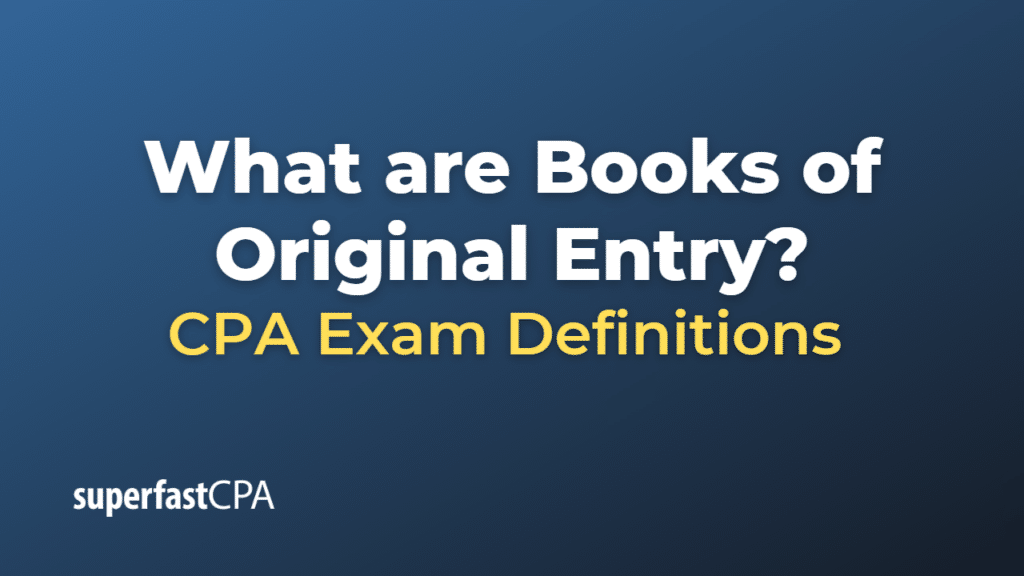Books of Original Entry
Books of original entry, also known as journals or daybooks, are the initial records where financial transactions are documented in the accounting system. They serve as the first point of entry for recording transactions before they are posted to the appropriate accounts in the general ledger.
In a double-entry bookkeeping system, each financial transaction affects at least two accounts, with one account being debited and another account being credited. Books of original entry are used to capture these transactions and maintain a chronological record of all financial activities.
There are several types of books of original entry, each serving a specific purpose:
- Sales Journal (Sales Daybook): This journal records all sales transactions, typically involving credit sales. It includes details such as the date, invoice number, customer name, and the amount of the transaction.
- Purchase Journal (Purchase Daybook): This journal records all purchase transactions, typically involving credit purchases. It includes details such as the date, invoice number, supplier name, and the amount of the transaction.
- Cash Receipts Journal: This journal records all cash inflows, including cash sales, cash received from customers for credit sales, and other cash receipts. It includes details such as the date, the source of the cash, and the amount received.
- Cash Disbursements Journal: This journal records all cash outflows, including cash payments for purchases, expenses, and other cash disbursements. It includes details such as the date, the purpose of the payment, and the amount paid.
- General Journal: This journal records all other transactions that do not fit into the other books of original entry, such as adjusting entries, accruals, and corrections. It includes details such as the date, a description of the transaction, and the accounts affected.
Once the transactions are recorded in the appropriate books of original entry, they are then posted to the general ledger, where the accounts are summarized and maintained. The general ledger serves as the basis for preparing financial statements and analyzing the financial performance and position of the business.
Books of original entry play a crucial role in the accounting process by ensuring that all financial transactions are systematically and accurately documented, which helps maintain the integrity and reliability of the accounting records.
Example of Books of Original Entry
Let’s consider a small business and look at how it records its transactions in various books of original entry.
Suppose you own a small electronics store, and during a week, you have the following financial transactions:
- Sold 5 smartphones on credit to customer A for a total of $3,000.
- Purchased 10 tablets on credit from supplier B for $5,000.
- Received a cash payment of $1,000 from customer C for an earlier credit sale.
- Paid $500 in cash for office supplies.
Here’s how these transactions would be recorded in the respective books of original entry:
Transaction 1: Sold smartphones on credit
- Sales Journal:
Date: (transaction date)
Customer: Customer A
Invoice Number: (invoice number) Amount: $3,000
Transaction 2: Purchased tablets on credit
- Purchase Journal:
Date: (transaction date)
Supplier: Supplier B
Invoice Number: (invoice number)
Amount: $5,000
Transaction 3: Received cash payment for earlier credit sale
- Cash Receipts Journal:
Date: (transaction date)
Source: Customer C
Amount: $1,000
Transaction 4: Paid cash for office supplies
- Cash Disbursements Journal:
Date: (transaction date)
Purpose: Office Supplies
Amount: $500
After recording these transactions in the appropriate books of original entry, they would be posted to the general ledger, updating the relevant accounts. For example, the $3,000 credit sale would be posted as a debit to Accounts Receivable and a credit to Sales Revenue in the general ledger.
Books of original entry help ensure that all financial transactions are systematically and accurately recorded, facilitating a clear and organized record of the business’s financial activities. This initial documentation serves as the basis for posting transactions to the general ledger and ultimately preparing financial statements.












